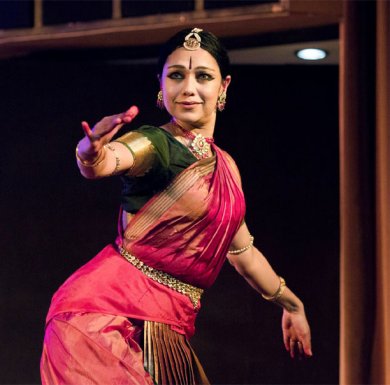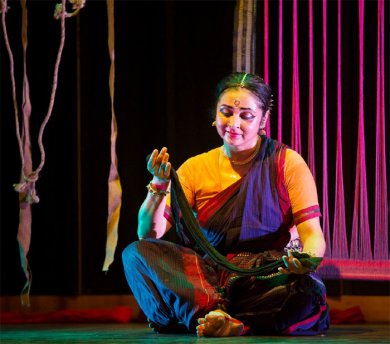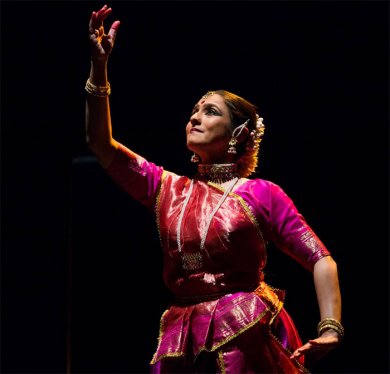
|  |

|  |
Parkaya's 3rd edition marks coming of age of the 'thinking' dancer - Shanta Serbjeet Singh e-mail: shanta.serbjeetsingh@gmail.com Photos: Inni Singh February 25, 2015 This title, suggesting the coming of age of the thinking dancer, is not meant to infer that the majority of them don't think. In fact, even for a visceral, body-centric art like dance, the cerebral content has always been amply evident in the careers of most good dancers, not to mention great dancers like Balasaraswati, Birju Maharaj, Kalanidhi Narayanan, Padma Subrahmanyam, Rohini Bhate, to mention only a few. What I am saying is that perhaps this itself, a new emphasis on thinking about dance rather than just dance, is a marker of our times. Also, that this process has shown a discernible, steady and upward growth, specially in the first decade of the twenty-first century. Dancers have realised that to compete with or rather stay on the same course in attention grabbing as some of the other Arts, such as the visual arts, they too must create an image that reflects their personality and their artistic vision. They have long known that classical dance has the substance and possibility to go beyond the mechanical, 'by rote' kind of movement. They have now understood that, however perfectly done, 21st century dance without evidence of the thinking cells and the 'conscious' sinews, will steadily be at a discount and unable to attain the gravitas that distinguishes the great from the good. Even when the well-trained dancer wins ecstatic exclamations of approval, the knowledgeable sit up only when they find evidence of a larger, personal vision, of an artiste who knows that behind those perfectly aligned karanas and taut adavus there has to be another awareness, an intuitive knowledge that the physicality of the body must be in perfect sync with a planned, structured, deeply thought-out, personal style and 'look.' The first step in the direction came with the move from solo to group work, in the early 80s, as a response to new cultural stirrings and the role that officialdom began to see for export of India's great cultural heritage in the pursuit of newly perceived goals of cultural diplomacy. Suddenly, the Sarkar needed large, group shows in aid of new cultural diplomacy initiatives, and the first step in this direction could be said to have been taken by Birju Maharaj way back in the Festival of India days in the Eighties. Armed with government patronage and resources at Delhi's Kathak Kendra and faced with the need to adapt a strictly solo form like Kathak to the unfamiliar terrain of new spaces abroad, such as the stadium sized concert halls of the Soviet Union and Europe, Birju Maharaj began experimenting with choreographic works involving many dancers. Kathak's structure in its rudimentary, basic form lent itself well to balletic design. It sits easy on the eye with pirouettes and spins and if the cognoscenti missed the delicacy of its abhinaya and bhava paksha, no one was yet aware of where all this would lead. By the end of the 20th century, all classical dance styles now followed the same model -multiplication of dancers on stage and greater emphasis on elements other than dance like sets and lighting design. Soon group work by established dancers all over India became de riguer for almost all dance styles. Perhaps the next departure was by legendary maestros like Guru Kelucharan Mohapatra, Birju Maharaj, Sadanam Balakrishnan and some younger dancers in duets and trio coming together in a grand finale in a memorable production at Calcutta's moon-washed Victoria Memorial terrace. A notable individual effort was by Bharatanatyam dancer Prathibha Prahlad who conceived of all the seven styles in one production, each style with its own 'specialist' dancer dancing to her own music and all coming together in a grand finale appropriate for a large stage like that of Purana Qila. Prathibha called it "Panchajanya" and presented it under the baton of ITDC. Thereafter, the tweakings of that idea have been so many and by so many well known dancers and organizations, including the sarkari Sangeet Natak Akademi, that I, personally, have lost count. Somewhere in all this whirligig, thought and original creativity got submerged. Not that the dancer's art was lost. Wonderful, charismatic experiences were created and the examples are all at hand: dancers like the Nrityagram girls, Bijayani Satpathy and Surupa Sen, Malavika Sarukkai, Alarmel Valli, Padma Subrahmanyam, Chitra Visweswaran, Anita Ratnam, Rama Vaidyanathan, Madhavi Mudgal, Sharmila Biswas, Prerna Shrimali... This piece is about one such evening a few weeks ago. It featured three forms and three dancers, opening with Parwati Dutta's Kathak, Rama Vaidyanathan's Bharatanatyam and Sharmila Biswas's Odissi. For their recent work in this latest, third edition of Sarvam's annual festival 'Parkaya,' the body of another, each dancer was asked to work with another visual art form, interpret it according to her own creative insight and develop her own personal dialogue with it. Thus, Parwati Dutta chose 'Varnajaa,' a play with Calligraphy, Odissi exponent Sharmila Biswas's 'Aparkaya' looked at Textiles and Rama herself counterpointed Bharatanatyam with miniature paintings. How far these presentations worked is the burden of this essay. When looking only at dance as a pure, unalloyed art form, the first question is whether the work was able to give the viewer a glimpse of that special, magical core that is yet unmanifest, as in an acorn. It awaits that moment when the process of photosynthesis will happen and when you will actually be able to see life growing in that dead-looking, hard nut. The rest is easy: to help you to imagine the spreading green boughs and leafy branches of the oak tree as it will become one day. And yet, I imagine, this process would have taken the 'thinking' dancer over a mountain of burning coals! Says Rama, "Fortunately, I have Neha Bhatnagar who under her organization Sarvam does an extremely dedicated and meticulous presentation of the festival." Neha is herself a Bharatanatyam dancer, someone who is not content to define herself by just that bare description. She was an intern with Shashi Tharoor when he was Minister of External Affairs in the UPA era, is a TED speaker, a social activist and someone who is aware of the urgent need to make other young people like her see the beauty of the classical arts. 'Parkaya' or 'The Body of Another' has always fascinated writers and thinkers. Mankind's search for self among a web of complex relationships has been the writer's favourite tool the world over. Girish Karnad's Hayavadana was influenced by Thomas Mann's The Transposed Heads, which in turn is borrowed from one of Sanskrit's well-known Kathasaritasagara stories. It is a fascinating story. When two friends transpose their heads, the brawny one's head is exchanged with that of the thinker and the 'pehalwan's with the arty friend. The old bodies are now led by unfamiliar heads with their own new way of looking at familiar landscapes, a new reality that changes everything. Society is best reflected through its culture and the use of myths and legends from our classical and folk culture colours the concept of 'Parkaya.' It is good to see contemporary dancers grappling with abstract concepts and issues such as theatre and painting have long done. I have no doubt that dancers will, eventually, find their own distinctive interpretation of these highly abstruse and existentialist concerns and that their search for identity too, will find new tools and vocabulary from within their dance itself. Knowledge of all the classical arts, of music and dance, of course, but also of the literature of the world, of theatre and stage presentations, and someone like Gowri Ramnarayan immediately comes to mind, is a definite help. Translating 'Kathasaritsagara' or Thomas Mann in the language of dance is no child's play. But what the "thinking" dancers are doing these days is no less interesting. And no less challenging. For the first time the dancers are competing with the painters and the sculptors. If the visual artists have no recourse, or little recourse, to words, the dancers too, have only the language of movement Neha has this to say about developing the concept of 'Parkaya': "As a performing artiste, I realized that it is very easy to get into our comfort zone and go on doing the same things that we are familiar with. No doubt it brings in a new sheen to the evergreen compositions, but I feel it does not help in the evolution of the dance form. For that it was imperative that we take up challenges that will help not only to push boundaries but also act as a catalyst to step up the adrenalin. Therefore, the concept of 'Parkaya' where I challenged intelligent dancers to open new windows for themselves and keep the inspiration going for the performers as well as the rasikas."  Rama Vaidyanathan
In CHITRAVALI, Rama brought her usual deep insight into the classical theme of Radha and Krishna and how the duo merged their own identities, the one into the other. Against a beautiful selection of miniature paintings as a backdrop, Rama first showed two nayikas, virohoni and abhisarika. The first established the totality of all existence, of the human, the environment, literature and music. The nayika etches the picture of trees, how they enable to sustain birds to live, by giving them a dwelling place, sustenance through fruit and nuts and berries, and humans who are yearning for shade…In Abhisarika, the nayika sets out to meet Shyam and encounters the classical obstacles of the bibhuti wearing yogi, the snake, the bird..the landscape clouded by dark clouds and the torrential rain..."Umad Ghumad Chhai / Shyam ki chavi more man mein aayi / ghan ghore ratiyan / pee ki yaad aayi / Ghan shyam bina / shyam shobhit nahin..." Well known poet and Radha Krishna expert, Harsh Deheja composed this lyric and overall guided Rama in selection of the miniatures. Dancers reaching out to experts from other disciplines is also a welcome trend. The singer Ranita Dey is a disciple of Ajoy Chakravarti and the piece set to raag Nat Malhar, created a beautiful cameo of the classical Radha. The thumri that followed amused me by its stress on varna, colour, a never-ending issue in India, it seems. A match on behalf of Krishna has been carried to Radha's family. Here is the response: "Kanhaiyan tora kara mein kaise bihaun Radha," (How can I marry off my fair Radha to your dark-hued Krishna?) The retort is sharp and colourful. Says the match-maker: "Kara kara mat kaho /Hum ko lage piyara / Wo to brij ka hai ujiara / Apni Radha rakho ghar mein / jeeta rahega Krishna kuwara" (Don't call him dark! He is the light of Braj and beloved of everyone. Keep your Radha at home. Our Krishna will do very well by remaining a bachelor) The climax, set to a Dhrupad, began slowly but then progressed to a sure acceleration of rhythm until, at the end, it became a crescendo and showed Radha and Krishna as one. A truly movingly choreographed piece. Here it no longer mattered which was Krishna and which Radha. "Krishna tum namaho / Radhatmic, Krishnatmic..." It is the famous episode in which Radha playfully exchanges her clothes with those of Krishna and Krishna now becomes Radha… Set against the equally famous 18th century Pahari Garhwal painting which illustrates this story, we see Radha in a seated pose, in the vortex of two overhead white, diagonal lights, using only her abhinaya to paint before you slowly, lovingly the emerging form of a Krishna, now a fair belle, complete with Radha's nose-ring, her bejewelled nath, the payal, the lotus in the hand…. The picture of the gender changeover complete, she stands up, again in the centre of the two lights, the orchestra in pitch darkness, and walks in the path of light towards that marvellous, anonymous Garhwal painter's rendition of this very scene. The visual, textual and beautifully danced message become one in conveying how the one can become the other. Sharmila Biswas presented APARKAYA, an interpretation of the art of the weaver, of the woven cloth and of the story of Sita worked in as warp and weft of life itself. And what a kinetic fabric she wove! It rivalled the intricate jewel-like colours of Banarasi brocade, the silken texture of a Jamadani sari, the energy of a Santhal fabric and the gorgeous sheen of a dhakai muslin! To be able to give life to a character, says Sharmila, "it is not enough to be informed (even if it is in the greatest detail) about it. Through the information gathered one has to first build a convincing image. Then comes the greatest challenge - the actor has to form a bridge through which the character can come in and reside within the actor. The actor has to lend part of herself and take as much as possible from the character, to finally give the breath of life to the character. Only after this process is complete, does the character gain credibility, and the actor is truthful in her depiction. Once this process is over, the experience is stored in the actor's heart and the actor is allowed to be free and herself again. From then onwards, for every performance, the character flows out effortlessly from the storage, enabling the actor to give a convincing and honest performance." "Was this production more difficult than others?" I ask. "In none of my earlier productions," says Sharmila, "did I have to struggle so much with this process, as both Vedvati and Sita (Vedavati was Sita's first incarnation, taking birth as Sita to avenge her defilement at the hands of Ravana) in Aparkaya, have very different natures from the characters I had done before, and also from my own nature. I can honestly say, for me, it's still a work in progress, but I have been able to build the connecting bridges, and I am allowing the two characters to come in." Valmiki's Ramayana, on which Sharmila bases her production mostly, narrates the story of Vedavati in brief. She is the daughter of Kushadwaja, the granddaughter of Vrihaspati and is born out of the utterance of the Vedas. She is dedicated to Lord Rama. This Ramayana describes Vedavati as a dark beautiful lady, wearing tiger skin, engrossed in the pursuit of knowledge to attain Vishnu. When Ravana defiles her, considering herself to be impure and her life futile, she enters fire with the resolution to be born again to bring the death of Ravana. Sharmila created the image of Vedavati from this sketchy description. Her Vedavati is a middle aged woman, completely detached from the world, obsessive about her twin desires to attain Vishnu (the unattainable), through her path of knowledge (gyan marg) and to seek revenge on Ravana. She is high strung, highly impractical, swinging from a maniacal to a depressive state of mind. Ravana had touched only a strand of her hair, but perhaps such was the demand of the age that she considered herself ruined, and forgetting her main objective of life, enters fire.  Sharmila
Biswas
Sharmila says, "I am personally very focused, and of course at times can be obsessive. Yet, I think I am very connected with the world around me. But I have seen a few of that kind of women. To be respected from a distance, not the giving or nurturing type, and no one would dare to put an arm around her, and let her have a good cry. Or laugh. While preparing for the role, I imbibed from these lonely women. Now, the Sita I imagined for the production was radically different. She is the daughter of nature. Totally unaware of her qualities, good or bad. She laughs easily, cries easily, gives more easily. She is impulsive; she is an ordinary good soul. She knows how to deal with her husband in every situation, to get the best deal in the long run. Her path is the path of bhakti-shringar. Without any bookish knowledge, she has common sense, and a sense of propriety of auchitya. That's why she could so easily tell Rama that she had no qualms about state of purity of her body, which could never be in her control. I have very little in common with Sita, but I have seen such women, mostly while I was working in the interior villages of Odisha. Observing them, I have learnt a lot about the laws of nature from these women, which have brought me much happiness and peace. For Vedavati, Sita was not only a weapon, but almost her daughter. Sita was born out of her wishes of revenge. A very disappointing child, a weakling, according to Vedavati. She had tried, at every point, to interpret Sita's motive and nature, to impose and manipulate. And at every point, she is compelled to question the validity of her own promise of revenge. Even after slowly getting converted, she could not change herself so easily, and her stubbornness would always win over her gradually melting heart, until the end, where Sita so simply and effortlessly absorbs her within herself. This pattern, I can understand completely. As I am growing older, I am beginning to enjoy simple gifts of life more, I am being able to let go more easily, and am slowly realizing that the responsibility of the entire world is not on my head. World will survive without me. For me, Aparkaya will always be a personal learning experience, quite therapeutic. Aparkaya has helped me to appreciate the fact that knowledge, however precious, can never come above human values and emotions. I do hope it will make me a more generous person." To best understand how Sharmila gave form and line to this narrative, it is necessary to see the process she followed. Even here she only knew what she did not want - to make the production a pretty display of costumes and props. The first stop then was to interact with Bhubaneswar's Weavers Service Centre. "Through their generosity and guidance I could get in touch with the weavers of Nuapatna and Mayurbhanj." The weavers have a common language and in Orissa, as elsewhere, the warp is called Tani which are lines of thread without design. The weft is called Bharani, the process in which the basic structure is filled up with the design and the countless intricacies of pattern. One is reminded of the poetry of the arch weaver Kabir when one reflects that in weavers' parlance, life is compared with Tani and what happens with life, its myriad experiences and stages is Bharani. Interestingly, says Sharmila, the most important puja of the weavers is Ghora Navami. Ghora or horse symbolises speed, dexterity, power and productivity, all appropriate symbols for the art of weaving. In Nuapatna, Sharmila came into contact with the loom, the beautifully shaped instrument used by the weavers. Above all she was inspired by the manner in which they work with thread and cloth. It was possible for her to sense why designs are not merely shapes and colours for the weavers. They are almost animate and it was possible for the weavers to communicate through them.  Sharmila Biswas and group in APARKAYA Photos: Avinash Pasricha The literary props for the story came from her introduction to Tapaswani, a work by a renowned Oriya poet, Gangadhar Meher, himself aware of the art of weaving as he belongs to a weaver's family. Tapaswani is Meher's interpretation of Sita from the Uttar Ramayana. This Sita is charming, earthy, very touching. While the concept of Parkaya was seen through the two Sitas, the one dark and vengeful, the other, her incarnated version as someone not interested in revenge and dark impulses, the dancer herself communicated through the metaphor of music and cloth, weaving all three into one fabric of life and art. Interestingly, the weavers tell the story of the production through their singing. And music, traditional and folk, like the cloth, from different folk traditions, from Dongria and Kotpat, Bomkai and Santhal, matches the inputs of the music from the Daskathia, Pala, Karma, Bhagabat traditions and even Prahalad Natakam traditions. It turned out to be a charming device. Kudos, Sharmila!  Parwati Dutta
Parwati Dutta's opening presentation VARNAJAA with both Kathak and Calligraphy used the parallels of the two forms to convey the eternal search for making manifest that which is unmanifest. At the beginning of time, it is said, there is the primordial sound, the "Unhudd Naad," sound which was there but not heard. It led to Naad, sound wherein 'akaara,' form, is said to have become manifest. In the Islamic art of calligraphy, the only representation of the Creator, this is the only art, other than architecture and some forms of music that is allowed as aesthetic expression. 'Akaara' as form is expressed as script, syllables and shapes. Both Kathak and Calligraphy appear spontaneous, fluid, open in nature. Yet both are highly choreographed, each movement and stroke deliberately designed. Parwati says, "The constructed experience is no less true than a natural one. Each word within a finished piece of calligraphy is self-contained, an independent spatial experience." But an entire evening of similar abstract swirls and spins, be they in movement or script, can get repetitive. Her music, a very fine ensemble where each artist was a master artist, could have helped introduce the much needed shading or perhaps recourse could have been taken to some other art form, say poetry or a folk form like Chitrakathi, the traditional art of shadow puppetry originating in Goa. Here, the artist uses plain paper that is about 15" x 12" in size, and paints pictures in a unique, primitive, art nouveau style that may have helped introduce "the body of another." Parwati Dutta needs to think further about it..  Shanta Serbjeet Singh, for twenty-five years, columnist, critic and media analyst for The Hindustan Times, The Economic Times and The Times of India, is the recipient of the Lifetime Achievement Award of the Sangeet Natak Akademi and Delhi Govt.'s Sahitya Kala Parishad for her contribution to the field of culture. She just finished her term as Vice Chairman of the SNA, is the founder-secretary of the World Culture Forum and continues as Chair of the UNESCO created NGO APPAN (The Asia-Pacific Performing Arts Network), a position to which she was appointed in 2001. Singh has authored several well-known publications such as 'Indian Dance: The Ultimate Metaphor' (published by Ravi Kumar (Paris), 'The 50th Milestone: A Feminine Critique' (Sterling Publishers, to mark India's fiftieth anniversary of Independence), 'Nanak, The Guru' (Oxford University Press) and 'America and You' (22 editions). Comments A fantastic article detailing the fine lines and tapestry of thought in 'Parakaya'. I am awed at the thought process that went into the process of building the imagery. I hope this production comes to Mumbai. Thank you, Shanthaji. Love your writing as always! - Anon (March 3, 2015) Post your comments Pl provide your name and email id along with your comment. All appropriate comments posted with name and email id in the blog will also be featured in the site. |